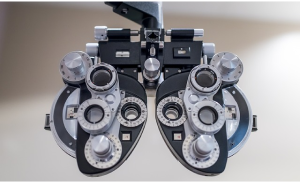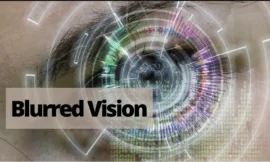Table of Contents
- EVO ICL vs. LASIK; a quick comparison:
- Optical Procedure ICL vs LASIK procedure explained:
- Is ICL an alternative to LASIK or not?
- EVO ICL vs. ICL: a better refractive error-fixing surgery:
- Frequently Asked Questions
It’s too pessimistic to look at the EVO Implantable Collamer lens, EVO ICL vs. LASIK while considering surgical options for nearsightedness and astigmatism. Seeing things blurry, having problems with vision, not being able to watch the beauty of nature, worrying about glasses, and other eye problems worsen things. Using optical instruments like glasses, lenses, etc., also costs you financially.
In EVO ICL, a biocompatible lens made in the medical laboratory with collagen and synthetic plastic is used between the eye tissue iris and natural lens. While in LASIK eye surgery, a flap is created via a laser to correct the refractive error by reshaping the corneal tissues. It would help form an image on the retina at the right position.
EVO ICL vs. LASIK; a quick comparison:
While comparing the two things, the primary purpose is to make the right decision. The same goes for comparing EVO ICL vs LASIK, as most patients want to know what surgery is the best possible solution for their eye problems. The knowledge a patient perceives would help them to choose the right optical center for their treatment. Here are the details that would help you make informed decisions about your eye treatment.
| Treatment Name | EVO ICL | LASIK |
|---|---|---|
| Abbreviation | Evolution in vision freedom, Implantable Collamer lens. | LASIK is the abbreviation of laser-assisted situ in keratomileusis. |
| Father of Methods | Kimiya Shimizu, a Japanese Doctor, introduced ICL. | Peyman, an Iranian American Ophthalmologist. |
| FDA Approval Date | 26 January 2005 | 25 March 2022 |
| Treatment of Optical Diseases | Only nearsightedness and astigmatism can be treated with EVO ICL. | LASIK does not help treat farsightedness along with astigmatism. |
| How Much Does it Cost? | The cost for EVO ICL is around 3000-6000$ in the USA and 2800-4500£. | LASIK costs around 1500-3000 $ in the USA and 2500-3000£ in the UK. |
| Surgery Time | The time spent in the operating theater is around 40 minutes for both. | The surgery time is about 25-30 minutes for both eyes. |
| Analgesic Drops | After Effects | Local anesthesia along with anti-depressive sedative |
| Healing Time | It usually takes 3 months for the whole recovery. | Whereas LASIK requires 6 months for complete healing. |
| After effects | It may cause sensitivity of vision and vision problems during the night. | It can cause dry, itchy, and inflamed eyes because of numbing or sedatives. |
| Lastingness | It would last over a lifetime except for exceptional cases. | It also lasts for a lifetime unless any medical or physical factor may be involved. |
Optical Procedure ICL vs LASIK procedure explained:
These procedures are designed to treat refractive error via corneal adjustment. An eye surgeon will take you out of the woods if you are worried about blurriness (astigmatism) and nearsightedness (myopia) and are interested in any treatment method.
Effective treatment for Myopia (Nearsightedness) with or without astigmatism: EVO ICL
Implantable Collamer lens (ICL) is an ocular method in which a certified ophthalmologist would do surgery in the operation room, where he will first inject local anaesthesia to avoid any discomfort during the procedure. An eyelid opener is used to prevent blinking during the ICL surgery to proceed with the surgery smoothly. With carefully, 2 small incisions would have to be created by the lasers. The optical staff would do it so the ophthalmologist would fit the Collamer lens at the right site.
A senior ophthalmologist surgeon with professionally certified staff would go for ICL surgery after conducting comprehensive research about the patient’s previous medical history. With an ardent passion for perfection and hope to treat myopia and astigmatism, ophthalmologists would place the biocompatible Collamer lens between the iris and the natural lens in the posterior chamber. For clear vision and to get rid of blurred vision, a patient would have to swallow the pill for ICL.
After giving local anaesthesia and anti-depressive medicines (if needed), the total time this procedure will take is around 20-30 minutes for each eye. You would wonder if this surgery required not too much time. You may feel mild or no pain during the procedure because of numbing drops. After surgery, you will see a clear image created at the retina in the correct position.
I have done extensive research and found that the success rate is about 75% of people who have gone ICL got their vision clear 100% while the remaining 25% have improved to 80%.
LASIK Surgery in brief:
Laser-assisted in situ keratomileusis (LASIK) surgery is well known for its efficiency. Thousands of people are getting LASIK surgery daily for their eye treatment to avoid the usage of lenses, glasses, and other types of optical instruments.
After confirming that you are an ideal candidate for the LASIK surgery, your doctor will give you an anaesthetic dose to prevent discomfort. Then, a laser beam is used to create a corneal flap using advanced technology, and lasers are directed toward the eye. After fixing the refractive error, the surgeon will fold back the corneal flap to its position. The light will form an image in the right position for a clear, real, and inverted.
There would be no pain during the whole procedure because you were given the anaesthetic medicines via injection or maybe oral methods. In the surgical room, creating a corneal flap, fixing refractive errors by reshaping the cornea, folding the flap to its actual position, and applying medicines would take about 20-30 minutes for both eyes. It is a quick and efficient way to get rid of myopia or not have blurred vision problems.
If you want to know about the success rate of LASIK to get a little satisfaction, then it is informed that LASIK got approval from the FDA before the implantable Collamer lens surgery.
The success rate is about 90.2%, and the patients after getting LASIK surgery have cleared vision after 7 days of their surgery. The side effects a patient can experience are dry or itching eyes that can be cured via ophthalmological drops that your doctor will prescribe you after the surgery.

Is ICL an alternative to LASIK or not?
After the approval of LASIK and EVO ICL, thousands of people benefit from these procedures. These surgical procedures are not just painless; they are also;
- Effective.
- Taking less time.
- It does not have too many adverse effects.
- Performed by advanced technology.
- It does not require piercing or stitching.
- Cost-effective as compared to glasses and lenses.
ICL is not the alternative to LASIK because, for LASIK, you would have to qualify the specific requirements such as
- Age over 18 years
- Have healthy cornea
- Do not have dry eyes.
These can decrease the success rate of LASIK surgery, but you don’t have to worry if you have such symptoms as getting treatment from a certified professional ophthalmologist. The reason is that a senior certified doctor will not put all his eggs in one basket. He would opt for the EVO ICL method if you got a refractive error. Dr. Sarah from New York, with 15 years of experience, has helped hundreds of people with their vision problems with LASIK, EVO ICL, SMILE, and PRK.
EVO ICL vs. ICL: a better refractive error-fixing surgery:
Once you have decided that you want to go for eye surgery, after an initial medical checkup and necessary laboratory optical tests, your doctor will suggest you go either for EVO ICL or LASIK. It would depend on several factors, like
- Age of the patient
- The health state of the cornea
- Have no hormonal changes
- Have no blood pressure disease or diabetes.
After looking at these criteria and other things noticed during your consultation, an ophthalmologist would describe which surgery would be right for you. If you don’t have healthy cornea or dry or itchy eyes at 23 years of age, then there are higher chances that an ophthalmologist would advise you to go for EVO ICL because, in LASIK, there would be the chance for swelling with other complications. If you are 18 plus and below 21 and have astigmatism, then LASIK would be the possible option for you to get clear vision. These surgical options would allow you to enjoy the fairy mountains, flashy rivers, and the other natural beauty of this world.
Frequently Asked Questions
Is LASIK or ICL better?
The surgery is better for you, depending on your previous medical history and the current tests you have undergone. If you have a healthy cornea and meet other specific requirements that have been discussed above, then LASIK is better.
What are the disadvantages of ICL?
The most noticed EVO ICL disadvantages include the sensitivity of lights, hazy vision at night, retinal detachment, and sometimes eye swelling, as well as some other infectious diseases.
Why choose ICL over LASIK?
Choosing ICL over LASIK would be in the situation if you do not have a healthy cornea, are between 21-45, have nearsightedness with or without astigmatism, and have no hormonal changes.
Why is LASIK preferred over ICL?
LASIK should be preferred over ICL if the patient has a farsightedness problem with or without astigmatism (blurry vision), has a healthy cornea, and is over 18 years old.
References:
Center for Devices and Radiological Health. (2021, June 17). The FDA’s LASIK program. U.S. Food And Drug Administration.
Center for Devices and Radiological Health. (2022, April 18). EVO/EVO+ VISIAN Implantable Collamer Lens – P030016/S035. U.S. Food And Drug Administration.
Professional, C. C. M. (n.d.). Implantable Collamer Lens (ICL) surgery. Cleveland Clinic.



![Explain Contoura LASIK: A Topography Guided Surgery [2024]](https://healthstreamings.com/wp-content/uploads/2024/01/Contoura-LASIK-2-1-270x162.webp)
![Exclusive PRP Hair Treatment Cost in the US and UK [2024].](https://healthstreamings.com/wp-content/uploads/2023/11/PRP-hair-treatment-cost-3-270x162.png)